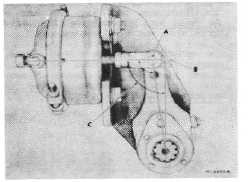SERVICE MANUAL
3.
Turn vehicle wheel and at the same time rotate
adjusting screw until brake shoes are tight
against drum.
4.
Back off adjusting screw just enough to eliminate
drag.
5.
Make and hold full brake application to fully seat
brake shoes against drum and note the angle
between slack adjust and push rod. This angle
should be a minimum of 90 degrees or more.
If the foregoing adjustment or relining of brake shoes
does not establish an angle of near 90 degrees between
push rod and slack adjuster with brakes applied (Fig. 2),
then maximum force against slack adjuster cannot be
obtained. Readjust push rod as follows:
1.
Disconnect slack adjuster and push rod. Do this
carefully because slack adjuster may be turned
toward
brake
chamber
with
considerable
pressure.
Fig. 2 Brake Chamber and Slack Adjuster
A
Slack Adjuster More Than 90° in Released
Position
B
Applied Position
C
Angle Should be 90° in Applied Position
2.
Loosen lock nut on clevis and thread clevis onto
push rod toward brake chamber for several
turns.
3.
Reconnect slack adjuster and push rod with
clevis pin.
4.
Make a full brake application and check angle
between slack adjuster and push rod. If 90
degrees or slightly more is not obtained with
brakes applied, repeat adjustment until angle is
satisfactory.
The desirable situation is to bring brake shoes against
drum just as the slack adjuster attains the near 90
degree position (Fig. 2).
MANUAL SLACK ADJUSTER OPERATION TEST
Slack adjusters should rotate freely without binding when
the brakes are applied and when the brakes are
released, all slack adjusters must return to the released
position freely and without binding. The slack adjusters
must be adjusted so that the angles formed by brake
chamber push rod and center of slack are near 90
degrees as described in BRAKE ADUSTMENT.
BRAKE CHAMBER SERVICE TEST
Operational Test
Apply and release the brakes, observing the brake
chamber push rod. The chamber push rod should move
out promptly and return to the released position freely
without binding.
Leakage Test
1.
Apply the service brakes and apply soap solution
to the chamber clamping area. If leakage is
noted, tighten the clamp ring bolts and if leakage
does not stop, the chamber must either be
reconditioned or replaced.
2.
With the service brakes applied, check for
leakage through the diaphragm by applying a
soap solution to the push rod opening and drain
holes on non-pressured side of chamber. No
leakage is permissable. If leakage is evident,
the chamber diaphragm must either be replaced
or complete chamber replaced.
LUBRICATION
Brake camshafts and slack adjusters should be
lubricated every five months or 26,000 km (16,000
miles). Refer to LUBRICATION Section for type of
lubricant. Do not overlubricate. Slack adjusters without
fittings require no lubrication. The provision for
lubrication may differ on slack adjusters. Some have
zerk fittings while others utilize pipe plugs or snap-in type
plugs or covers.
When brake linings are replaced, apply a thin coat of the
same lubricant to brake shoe anchor pins and
camshafts. Do not overlubricate.
CTS-4080W - Page 4

